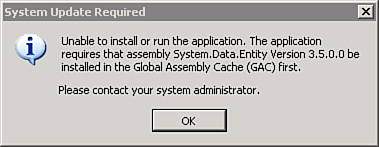PerformancePoint Dashboard Designer is the design
tool you use to build key performance indicators (KPIs), indicators,
scorecards, reports, filters, data sources, and dashboards. It also
enables you to deploy your finished dashboards to SharePoint.
Dashboard Designer is a .NET
Framework ClickOnce application that requires the .NET Framework 3.5
SP1. It also has a few other optional components that enable additional
functionality that users can install on their own, including the
following:
Note
If you deploy Dashboard
Designer in a highly secure environment, it is important to ensure that
the proper prerequisites are installed. If the .NET Framework 3.5 SP1
(Service Pack 1) is not installed, you see an error indicating that the
System.Data.Entity assembly does not exist on the client machine (see Figure 1). To resolve this, ensure that the .NET Framework
3.5 is installed and has been upgraded at least to SP 1. Figure 1 shows the error message you see if the appropriate
.NET Framework version is not installed.

You can determine which
service pack of the .NET Framework is installed on a client machine by
querying the HKEY_LOCAL_MACHINE\SOFTWARE\Microsoft\NET Framework
Setup\NDP\v3.5 Registry entry for the service pack value. The service
pack value should be 1 or greater than 1.
Visio 2007 or 2010
Professional is required on the client machine for creating or editing
strategy maps. Strategy maps are reports that enable you to connect KPI
data to Visio shapes to visualize data. Due to interoperability
requirements from the .NET Framework, it is important that the processor
architecture for the operating system match the processor architecture
for the version of Visio that is installed. If the processor
architecture does not match, it will not be possible to edit strategy
maps with that particular client machine. It is possible to work with
strategy maps by adding them to dashboards and creating links between
the strategy map and other PPS objects on the dashboard editor, but you
cannot create new ones. The following table summarizes the client
processor architecture compatibility for Visio and Windows (what
combinations work on the client machine).
| | Windows x86 | Windows x64 |
|---|
| Visio 2007 (x86 only) | Works | Does not work |
| Visio 2010 x86 | Works | Does not work |
| Visio 2010 x64 | N/A | Works |